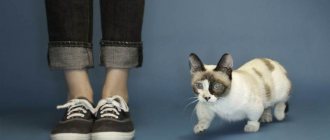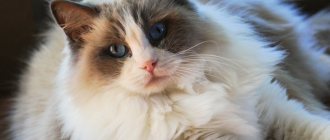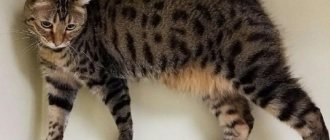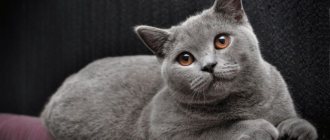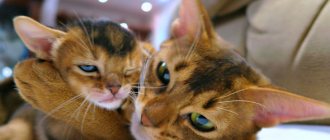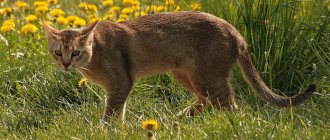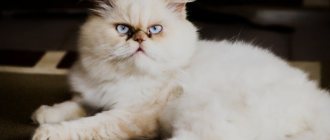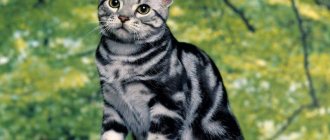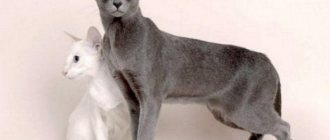Cats are the most popular pets. Therefore, breeders have worked hard and brought out many different breeds. Among them there are both giant animals and the most miniature ones, more like kittens. They are in demand among breeders all over the world.
Cats have long been no longer considered as a tool in the fight against rodents. In recent decades, the activities of breeders have been aimed at breeding ornamental breeds with an unusual appearance. Due to the fact that people have become fashionable for miniature pets, many dwarf cat breeds have been bred.
The vast majority of small cats were created through gene mutation and hybridization. Therefore, these breeds have certain disadvantages. The main ones:
- Limited gene pool.
- Little knowledge of hereditary pathologies.
- Instability of the species.
Despite this, representatives of dwarf cat breeds have a number of advantages:
- Unusual appearance.
- Such animals are distinguished by a calm disposition, kindness, and easy character. They very rarely show aggression or hostility.
- As a result of numerous studies, it has been proven that miniature cats help their owners cope with mental problems.
We present a rating of the 10 smallest cat breeds, whose weight does not exceed 4 kg.
Rating:
- Skif-tay-don
- Skookum
- Munchkin
- Singaporean
- Dwelf
- Minskin
- Kinkaloe
- Bambino
- Napoleon
- Lemkin
American Curl
Photo: Instagram/volgastyle_cattery
This cat breed has an unusual ear shape. Although, when the baby is born, his ears are straight, after a week they begin to curl. Hence the name of the breed, from the English “curl” - curly. Outwardly, such ears give the animals an expression of eternal surprise. The American Curl loves attention and children. An adult cat weighs no more than 4.5 kilograms and is one of the most expensive breeds.
Kinkaloe
Kinkaloo is a small fluffy cat with curved ears, like those of Dwelfs. Not surprising, because they come from the same breed - American Curls. Representatives of the second breed, munchkins and kinkalows, inherited short legs and a good-natured disposition.
Kinkaloo is recognized as an experimental breed; a lot of breeding work is carried out so that the offspring consistently inherit the desired traits, and the cats themselves remain very rare and cost a lot of money.
Parting words for future owners
If you decide to get yourself dwarf cats, then remember that the modest size of cats does not mean that they do not need to be looked after.
Here is a short list of procedures that even the smallest cats need.
Procedures:
- Clean your tear ducts regularly to prevent infection.
- Worm your pet
- Give crackers and chewing bones, brush your teeth so that there is no tartar
- Maintain a more or less balanced diet
- If your cat has long fur, be sure to brush it at least twice a week.
- Dress in winter cold, and in summer protect from prolonged exposure to the sun
- Visit your veterinarian regularly. Dwarf cats, due to mixing genes, may have weakened immunity and a predisposition to disease.
Following these simple rules will allow you to avoid many problems and enjoy the company of your pet for many, many years.
Toy-bob (skif-tay-don)
The smallest Russian cat breed, obtained as a result of a spontaneous mutation. In build, blue eyes and point coloring, Toy Bobs are similar to Thai cats. The tail is “hare”, twisted into a pom-pom. The coat is short, silky without undercoat, minimal care. Kittens are tested for cardiomyopathy and polycystic disease.
Sociable, friendly cats, typical talkative orientals. Toy beans are curious to the extreme, ready to play for days, and adore children. The psyche is strong - they easily endure unpleasant procedures, are not afraid of strangers, dogs, or changes in place. The little cat is endowed with great intelligence, quickly learning tricks and good manners.
Minskin
The Minskin is a miniature cat, whose distinctive features are short legs, silky skin and short, dense hair on certain parts of the body. The development of the breed began in 1998, when breeders took munchkins as a basis and crossed them with other breeds to obtain the desired coat.
Despite the fact that the new cat species has been officially registered, work to consolidate the characteristics of the experimental breed is still underway. The cats turned out to be very agile and fast, despite their short legs. They cannot jump high, but thanks to their agility they can climb to the desired height in other ways.
These are mostly healthy cats that love an active lifestyle, are very affectionate and need constant human attention.
Ninth place - bambino
Animals of this breed are short-legged hairless cats. They were the result of mating a short-legged munchkin and a Canadian Sphynx. This breed was bred in the USA, and the animals weigh 2.2 - 4 kg. Keeping a bambino is quite simple; you just need to remember that hairless cats often get sick. Therefore, in winter, if the apartment is too cold, dress your pet. This is not only good for his health, but also very stylish.
Singapore cat: 2-3 kg
Singapore cat
The Singapore cat breed has a rather sad past: they began to be bred from stray animals found on the streets of the city-state of Singapore. But thanks to their unique characteristics, current representatives of Singaporean cats can claim the best place in the house, because along with their small size they are distinguished by intelligence, devotion, and love for their owner. True, Singapore has not yet become widespread.
Buying a dwarf kitten
It’s hard to remain indifferent at the first glance at a touching little cat—a completely natural thought immediately arises: “And I want one like that...”.
It's impossible to remain indifferent to these little cuties.
How to decide on the breed
If you have seriously decided to engage in exhibition and breeding activities with cat minis, then such a desire is unlikely to have arisen spontaneously: you have probably already thoroughly prepared both theoretically and practically, and you do not face the difficult problem of choice - you have definitely decided on your breed. But if you just really want a small living charm to appear in your house, which will forever preserve the size and sweet disposition of the kitten, this is more complicated, and you need to weigh the pros and cons.
- Decide on your preferences - do you want a fluffy, short-haired or completely “bald” cat?
- Study the equipment - carefully read articles about the breeds you like, watch videos and photographs.
- Decide what level of animal you want to purchase: show, breed or pet class.
- Soberly weigh your financial capabilities - minis are not cheap, will you later regret the impulsive purchase?
- Discuss the purchase with family members - a pet should be a desirable acquisition for everyone, and not just for you personally.
- Find out where there are breed nurseries, find reviews about their work and pets.
- First, find specialists and consult with them - it is better to have a knowledgeable person help you in your choice.
How to choose a kitten
Nowadays it is not a problem to get the kitten you like literally from anywhere in the world - breeders and carriers will ensure delivery of the baby from home to home. But if there is such an opportunity, come for your little one yourself - you are purchasing not just a living toy, but a new family member, and personal contact in this case is very important. At the same time, get to know the breeder better, look at the kitten’s parents and the conditions in which they are kept.
When choosing a kitten, meet its mother
Do not hesitate to ask questions to the breeder - it is better to prepare a list of them in advance. Ask, among other things, about the health of your baby's parents, as well as kittens from previous litters, and whether they have had genetic tests. Draw up a contract for the purchase of a kitten - a responsible breeder will never refuse such a step.
Of course, neither all these measures nor a thorough examination of the baby guarantees that you are purchasing a healthy animal that fully meets the requirements of the breed standard. But you will know that you did everything you could for this - and may luck be with you and with the little tailed miracle that will enter your home!
Maybe this baby is waiting for you?
World “mini-record holders” in the cat family
The record holder for the smallest cat to this day is Mr. Pibbles, a smooth-haired tabby cat with white paws and toes. The body length is only 15 cm, weight is 1.5 kg, and it does not even reach a decimeter in height. Even in infancy, his growth stopped (presumably due to irreversible genetic changes).
The second example is Tinker Toy, a cross between a Himalayan and a Persian cat. At the withers, height is 7 cm, body length is 19 cm, and weight is 700 grams. This miracle of nature comes from Illinois (USA).
Another famous mini-cat is Heed. He lives in San Diego (California, USA), and stopped growing at 3.5 months. Its height at the withers is 8 cm, and its weight is about 900 grams. The reason for this development is genetic predisposition.
The list of small cats should be diluted with a kitty. This is Fizz Girl (Fizz Girl) of the Munchkin breed. According to her breed, she has short paws, and Fizz Gel’s paws are so small that the cat’s height is just over 15 cm.
It may seem that nature has “deprived” the cats mentioned in our ratings. However, this does not prevent wild breeds from getting their own food, and domestic ones from easily jumping onto the windowsill and doing other cat pranks...
Munchkin
Information about strange short-legged cats appeared back in the 19th century. Scientists were able to study individual individuals, and it turned out that the legs, 2-3 times shorter than usual, are the result of a natural mutation. Studies have shown that such a structure does not pose any danger to the animal and does not lead to dangerous diseases, therefore, since 1994, the development of the breed has taken place under the supervision of TICA.
Munchkins can have either short or long hair. When they look around, they do not stand up on their hind legs, but sit on their butts, while amusingly lowering their paws along their body. They can sit like this for quite a long time.
Munchkins became the founders of a whole branch of new species of cats, the results of crossing with this breed. Each has its own name, but collectively they are called dwarves - from the English "gnome".
Skookum
Short-legged curly cats that received curls from laperms. The wavy fur sticks out funny to the sides, which is why the pet appears disheveled. The fur coat is soft, but should not fall into tangles or icicles. Comb carefully with a wide-toothed brush. Bath only when necessary - water spoils the texture of the coat.
Skookums are energetic and charming, eager to make friends with everyone. From the Laperms they inherited strong nerves and high intelligence. They love children, dogs and anyone who is willing to play without being rough. Pets are tenderly attached to “their” person, they greet you home from work, and they purr at the sight of them.
TOP 10 most miniature species of wild cats
The rating is compiled “as it is” (it cannot be said that a person knows all the breeds of wild cats existing in nature).
• 10 • pampas cat
Found in South America, it has a dense build and is similar in color to a leopard. The weight of an adult is up to 8/11 kg (feline/cat), body length is up to 75 cm.
• 9 • jaguarundi
A miniature copy of a jaguar - as the name suggests. They have a flexible body and strong but short legs. Height at withers - up to 35/30 cm (males/females). Weight - up to 9 kg. They are found in a variety of places - savannas, forests, tropics. Secretive animals, but lead a diurnal lifestyle. They feed on small mammals, amphibians, birds, and fish.
• 8 • margay
The “long-tailed cat” (as it is called in its homeland) lives in South and Central America. The body length of this cat is 60~80 cm + 10 tail, and the weight of males reaches 8 kg. Leopardus wiedii leads a solitary nocturnal lifestyle, climbs trees well (and spends most of its life there). In America, hunting cats of the Margay breed is strictly prohibited.
• 7 • forest cat
Felis Silvestris is brown with black stripes. The body is up to 80 cm long (the tail is almost 35 cm), the weight of the cat is up to 6/8 kg, the height at the withers is about 35 cm. They are found mainly in Europe, northern Asia and Africa (African subspecies are the smallest in size).
• 6 • marble cat
Pardofelis marmorata inhabit Southeast Asia. Their body length is less than 55 cm + 50 cm counterweight tail, height is 45~62 cm, and weight is 2~5 kg.
• 5 • Kalimantan cat
Lives near Indonesia and Malaysia. Weight - from 2.3 to 4.5 kg, height less than 40 cm, body length - almost 60 cm. Almost elusive - the cat cannot be photographed in the wild.
• 4 • sand cat
The body length of these cats is from 65 to 90 cm (and almost half of this value is in the tail). The weight of males reaches 3.5 kg, and females - 3 kg. Dune cats live in deserts and rocky valleys and are nocturnal. They seem very cute, even though they are carnivores - they hunt jerboas, spiders, lizards, and insects.
• 3 • “rusty” cat
“Rusty” is its slang name (in Latin the breed sounds like Prionailurus rubiginosus). It became “rusty” because of its characteristic color - a mixture of gray, red, brown colors with an abundance of red spots on the body. It lives in Sri Lanka and southeast India. The height of a “rusty” cat does not exceed 30 cm, length (including tail) - up to 80 cm, weight - from 1.5 to 2 kg. Endangered species (the population is extremely small).
• 2 • Chilean cat
Kodkod (another name for Chilean cats) is an inhabitant of Chile and Argentina. The height at the withers does not exceed 22 cm, weight - from 1.5 to 3 kg, body length - up to 70 cm.
• 1 • black-footed cat
Black-footed cats (Felis Nigripes) have a body length of half a meter, a height of up to 20 cm, and the average weight of an adult is 1.8 kg. But don’t be fooled by the cute eyes and size of this baby - she skillfully hunts birds and rodents, and in captivity becomes very aggressive.
But there are representatives of the cat family so small that they can even be confused with rodents.
